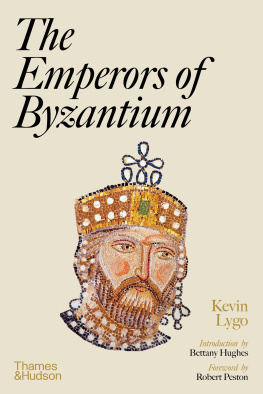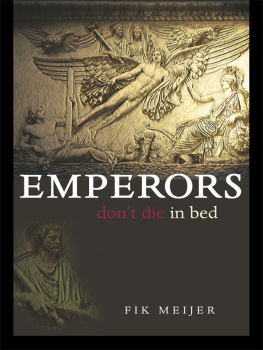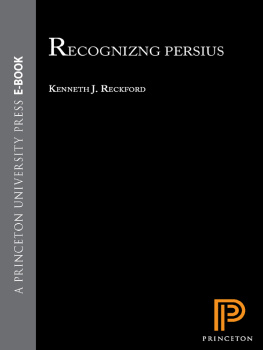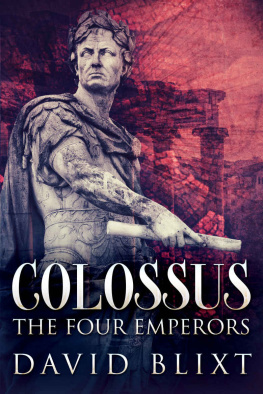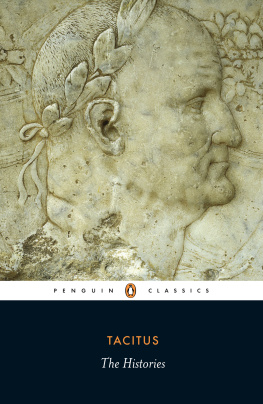Vitellius Aulus - The year of the four emperors
Here you can read online Vitellius Aulus - The year of the four emperors full text of the book (entire story) in english for free. Download pdf and epub, get meaning, cover and reviews about this ebook. City: London;Rome;Rome (Empire, year: 2005, publisher: Routledge, genre: Art. Description of the work, (preface) as well as reviews are available. Best literature library LitArk.com created for fans of good reading and offers a wide selection of genres:
Romance novel
Science fiction
Adventure
Detective
Science
History
Home and family
Prose
Art
Politics
Computer
Non-fiction
Religion
Business
Children
Humor
Choose a favorite category and find really read worthwhile books. Enjoy immersion in the world of imagination, feel the emotions of the characters or learn something new for yourself, make an fascinating discovery.
- Book:The year of the four emperors
- Author:
- Publisher:Routledge
- Genre:
- Year:2005
- City:London;Rome;Rome (Empire
- Rating:4 / 5
- Favourites:Add to favourites
- Your mark:
- 80
- 1
- 2
- 3
- 4
- 5
The year of the four emperors: summary, description and annotation
We offer to read an annotation, description, summary or preface (depends on what the author of the book "The year of the four emperors" wrote himself). If you haven't found the necessary information about the book — write in the comments, we will try to find it.
The year of the four emperors — read online for free the complete book (whole text) full work
Below is the text of the book, divided by pages. System saving the place of the last page read, allows you to conveniently read the book "The year of the four emperors" online for free, without having to search again every time where you left off. Put a bookmark, and you can go to the page where you finished reading at any time.
Font size:
Interval:
Bookmark:

THE YEAR OF THE FOUR EMPERORS
After the death of the infamous Nero in AD 68, the Romans might have hoped that AD 69 would usher in a new era of peace and stability. It was not to be. Before January was out, the new emperor, Galba, had been brutally assassinated, and the next two successors to the imperial throne, Otho and Vitellius, were to meet with equally violent ends. This period of turmoil also saw two desperate battles at Cremona, the capture of Rome for Vespasian fourth and final emperor of the year and a civil war in Italy which shook the farthest reaches of the Empire.
Yet AD 69 was notable for its historical importance as well as its compelling drama. It marked the watershed between the first and second imperial dynasties and the passing of an old order. The Senate, which had long been resting on past republican glories, was shown to be petty and ineffectual in its hour of crisis, while, ironically, the battles between rival Roman armies only enhanced their endurance. The military efficiency of the empire was not impaired by the civil war, and its political structure was reaffirmed.
Kenneth Wellesleys gripping account of The Year of the Four Emperors combines an elegant and exciting narrative with sound, meticulous scholarship based on his intimate knowledge of the Histories of Tacitus. Now with a new introduction and bibliographical material by Barbara Levick, the book will once more be welcomed as the standard work on this turbulent period in Romes imperial past.

Galba (top), Vitellius (bottom left) and
Vespasian (bottom right)
THE YEAR OF THE FOUR EMPERORS
Third Edition
KENNETH WELLESLEY
With a new introduction by
Barbara Levick

First published as The Long Year AD 69 in 1975 by Paul Elek Ltd
Second edition published 1989 by Bristol Classical Press
Third edition published 2000
by Routledge
2 Park Square, Milton Park, Abingdon, Oxon, OX14 4RN
Simultaneously published in the USA and Canada
by Routledge
270 Madison Ave, New York NY 10016
Routledge is an imprint of the Taylor & Francis Group
Transferred to Digital Printing 2005
1975, 1989 Kenneth Wellesley
Third edition 2000 Herta Wellesley, introduction 2000 Barbara Levick
All rights reserved. No part of this book may be reprinted or reproduced or utilised in any form or by any electronic, mechanical, or other means, now known or hereafter invented, including photocopying and recording, or in any information storage or retrieval system, without permission in writing from the publishers.
British Library Cataloguing in Publication Data
A catalogue record for this book is available from the British Library
Library of Congress Cataloging in Publication Data
A catalog record for this book is available from the Library of Congress
ISBN 0-415-23228-7 (hbk)
ISBN 0-415-232620-7 (pbk)
Contents
Figures
Plates
(a) Onyx head of Galba, 21 25 mm, British Museum, cf. H. B. Walters, Engraved Gems and Cameos, Greek, Etruscan and Roman, in the British Museum, no. 3606, pl. xlii. By courtesy of the Trustees, (b) Silver denarius of Vitellius once in the Herzogliches Mnzkabinett, Gotha. Legend: A(ulus) VITELLIVS IMP(erator). After L. M. Lanckoronski, Das Bildnis, 1944, pl. xiv. (c) Red jasper laureate head of Vespasian, 14 12 mm, British Museum, cf. H. B. Walters, op. cit., no. 1989. By courtesy of the Trustees.
(a) Billon tetradrachm of Alexandria, year I of Galba (July-August 68), Fitzwilliam Museum, Cambridge. Obverse: OY IB OYII TABA KAI LA Head of Galba; reverse: KPATHI Kratesis. cf. J. G. Milne, Catalogue of Alexandrian Coins in the Ashmolean Museum, 1933, no. 314. By courtesy of the Fitzwilliam Museum, (b) Aes dupondius of Rome, Fitzwilliam Museum. Obverse: IMP SER GALBA AVG TR P Head of Galba; reverse: LIBERTAS PVBLICA S. C. Libertas draped, carrying pileus and sceptre, cf. H. Mattingly, Coins of the Roman Empire in the British Museum I, 329, no. 121. By courtesy of the Fitzwilliam Museum, (c) Aureus of Rome, Hunter Coin Cabinet, Glasgow. Obverse: IMP M OTHO CAESAR AVG TR P Head of Otho; reverse: SECVRITAS P R Security, draped, holding wreath and sceptre, cf. A. Robertson, Roman Imperial Coins in the Hunter Coin Cabinet I, 172, no. 3. By courtesy of the Court of the University of Glasgow.
(a) Military Class silver denarius of Lyon (?), Fitzwilliam Museum. Obverse: FIDES EXERCITVVM Clasped hands; reverse: FIDES EXERCITVVM. cf. H. Mattingly, op. cit. I, 306, no. 65; C. Kraay, Revolt and Subversion, Numismatic Chronicle, 1952, 78ff. By courtesy of the Fitzwilliam Museum, (b) Silver denarius of Lyon (?). Obverse: A. VITELLIVS IMP GERMAN Head of Vitellius; reverse: FIDES EXERCITWM Clasped hands, cf. H. Mattingly, op. cit. I, 391, no. 114. By courtesy of the Fitzwilliam Museum. (c) Silver denarius of Rome, Hunter Coin Cabinet, Glasgow. Obverse: A VITELLIVS GERM IMP AVG TR P Head of Vitellius; reverse: L VITELLIVS COS III CENSOR Head of Lucius Vitellius, the emperors father, with eagle-tipped sceptre, alluding to the combined censorship (as colleague of Claudius) and third consulate of A.D. 47. cf. A. Robertson, op. cit. I, 177, no. 14. By courtesy of the Court of the University of Glasgow, (d) Aureus of Rome, 69/70, Hunter Coin Cabinet, Glasgow. Obverse: IMP CAESAR VESPASIANVS AVG Head of Vespasian, laureate; reverse: CAESAR AVG F COS CAESAR AVG F PR Bare heads of Titus (on left) and Domitian (on right), cf. A. Robertson, op. cit. I, 186, no. 2. By courtesy of the Court of the University of Glasgow.
(11. 14, soon after 15 January 69) and his wife Verania (11. 58, about 96100: cf. Pliny, Ep. ii, 20, 16), 77 83 cm, Museo Nazionale Romano (Terme), Rome. The photograph is reproduced by courtesy of A. E. and J. S. Gordon from their Album of Dated Latin Inscriptions, 1958, I, pl. 53c (no. 126).
CIL x, 7852 = ILS 5947 = MW 455 = Smallwood 392. Drawing made by the author from a photograph, kindly supplied by Dr David Ridgway, of a bronze tablet now in the museum at Sassari. It was discovered in 1866 near the village of Esterzili in south-east central Sardinia and is a locally made copy of an entry in the official register of the governor of the province. Another copy would have been sent to Rome and inscribed on a bronze tablet there, cf. T. Mommsen, Gesammelte Schriften v, 32551, F. F. Abbott and A. C. Johnson, Municipal Administration in the Roman Empire, no. 58, and A. C. Johnson, P. R. Coleman-Norton and F. C. Bourne, Ancient Roman Statutes, no. 181.
Sunk relief (Lepsius, Denkmler IV, 81a) on the south side of the propylon, outer face, of the Temple of Isis at Deir esh-Shelweit, Western Thebes. Otho, named in the cartouches as Mrqs Autuns Kysrs Autukrtr according to his Greek title, stands on the left facing right, and offers two pots of milk to two of the temple gods, Horus-Pr and Horus-Shu, to be understood as standing side by side. The former replies, I cause thy popularity to be great among everyone, that thou mayest rejoice in repeated years, the latter, I have placed love of thee among the people, that thou mayest be elevated through thy strength. (This note is based on a full description and translation kindly supplied by Mr Cyril Aldred and Mr Vivian Davies.)
Next pageFont size:
Interval:
Bookmark:
Similar books «The year of the four emperors»
Look at similar books to The year of the four emperors. We have selected literature similar in name and meaning in the hope of providing readers with more options to find new, interesting, not yet read works.
Discussion, reviews of the book The year of the four emperors and just readers' own opinions. Leave your comments, write what you think about the work, its meaning or the main characters. Specify what exactly you liked and what you didn't like, and why you think so.


